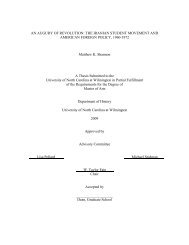HIERARCHAL INDUCTIVE PROCESS MODELING AND ANALYSIS ...
HIERARCHAL INDUCTIVE PROCESS MODELING AND ANALYSIS ...
HIERARCHAL INDUCTIVE PROCESS MODELING AND ANALYSIS ...
Create successful ePaper yourself
Turn your PDF publications into a flip-book with our unique Google optimized e-Paper software.
modeling. It makes for an easier construction of systems of equations by building in<br />
fragments.<br />
Table 1: In this table we are first giving an example of generic entity definition with<br />
its variables and parameters followed by an example of an instantiated entity, more<br />
specifically Phytoplankton - P, to which the variable “conc” is given a time series<br />
and the other variables initial values.<br />
pe = lib.add_generic_entity("P",<br />
{ "conc":"sum",<br />
"growth_rate":"prod",<br />
"growth_lim":"min"},<br />
{ "max_growth": (0.4,0.8),<br />
"exude_rate": (0.001,0.2),<br />
"death_rate": (0.02,0.04),<br />
"Ek_max":(1,100),<br />
"sinking_rate":(0.0001,0.25),<br />
"biomin":(0.02,0.04),<br />
"PhotoInhib":(200,1500),});<br />
p1 = entity_instance (pe,<br />
"phyto",<br />
{ "conc": ("system", "PHA_c", (0,600)),<br />
"growth_rate": ("system", 0, (0,1)),<br />
"growth_lim": ("system", 1, (0,1))},<br />
{ "max_growth":0.59,<br />
"exude_rate":0.19,<br />
"death_rate":0.025,<br />
"Ek_max":30,<br />
"biomin":0.025,<br />
"PhotoInhib":200 } );<br />
15
















